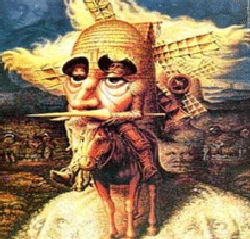Chapter 25 is a great example of this inter-shading (or intersticing, for there are holes lurking). "La penitencia de don Quijote" produces at least three different interrelated environments. First, Quijote's penitence is predicated on his knowledge of Amadís (and his transference to Beltenebros). This first environment is the pre-determined encoded life of Quijote, based on the objects and whims in los libros de caballería. In this sense, the enshrined environment of Amadís is a preterite environment, encased in Q's apperception. For penitence to occur, the Quijote's form must mimic, that is, mock Amadís de Gaula. This takes us to the present moment of the text occurring within in the depths of the Sierra Morena mountain range. Here the proper names of knights and squires begin to melt into the decrepit, grotesque world of Quijote. Along with the proper name follows the values: "su prudencia, valor, valentía, sufrimiento, firmeza y amor". These values lose their transcendental meaning and take on a rather blurry imitatio, becoming embedded in a specific location. Finally, there is a future environment produced by this mimesis. Something Quijote himself evokes when he begins to speak to the objects that surround him:
¡Oh vosotros, quienquiera que seáis, rústicos, dioses que en este inhabitable lugar tenéis morada: oíd las quejas de este dedichado amante, a quien una luenga ausencia y unos imaginados celos han tráido a lamentarse entre asperezas y a quejarse de la dura condición.... ¡Oh solitarios árboles, que desde hoy en adelante habéis de hacer compañía a mi soledad, dad indicio con el blando movimiento de vuestras ramas que no os desagrade mi presencia! (238)
I find this tonal reworking of environment (and even re-ordering) to be similar to what Cervantes considered his failed pastoral work, La Galatea, a work proclaiming to operate between a real pastoral setting and the genre's idyllic imaginary.

No comments:
Post a Comment